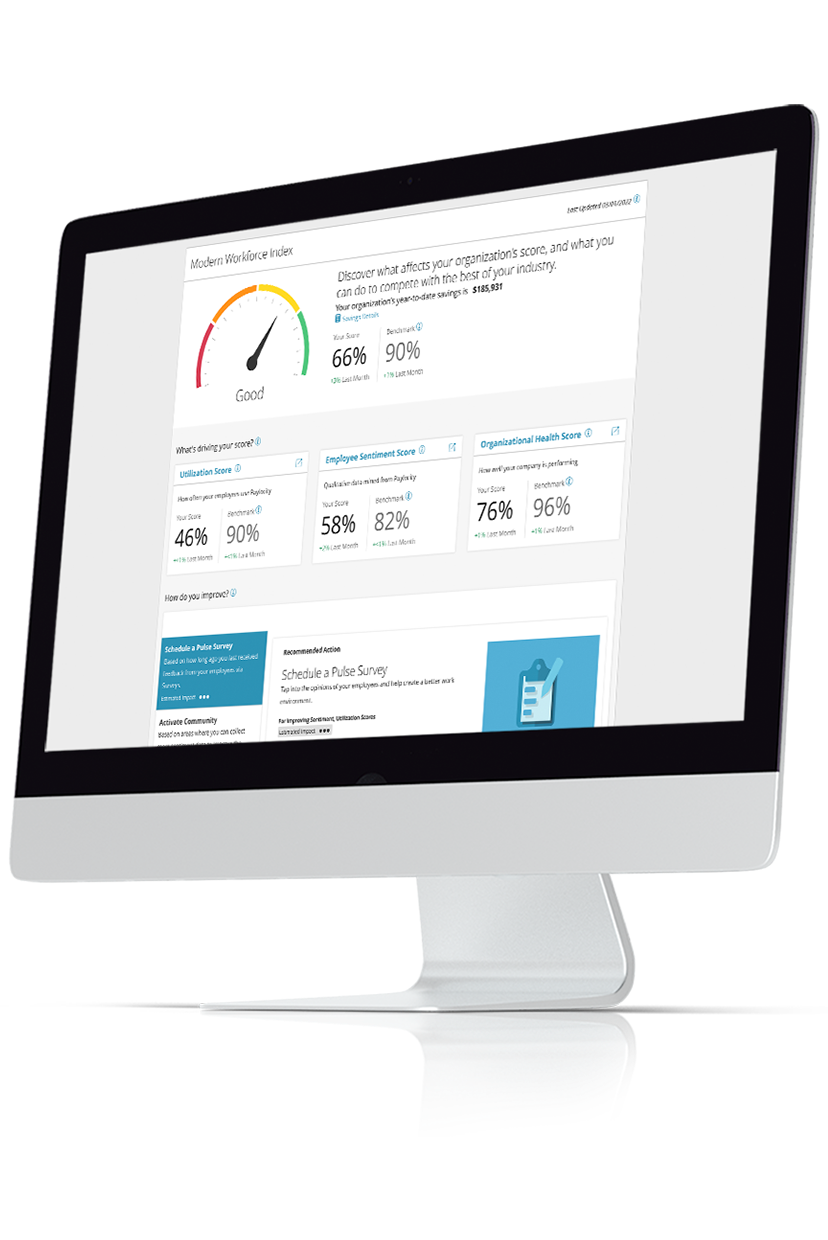resources
6 Ways to Build Employee Engagement With Remote and Hybrid Workers
August 11, 2022
Wondering how to engage remote workers? Set remote and in-person employees up for success with these six hybrid workforce engagement strategies.
Blog Post

In today’s competitive marketplace, companies are reevaluating their entire approach to work and quickly pivoting to accommodate employees wherever they are.
A recent survey from Gartner found that 76% of surveyed employees felt their work culture improved with a hybrid work environment. Additionally, companies that support their employees’ life experiences saw a 21% increase in high performers compared to companies that don’t provide the same benefits. Moreover, according to SHRM, a hiring process that involves both virtual and in-person aspects will become increasingly normal. With these shifts in the way we work, it becomes imperative to continue to engage remote and in-person workers.
The challenge is that many organizations didn’t and still don’t have the systems to truly engage employees in their new hybrid or fully-remote workplaces, leading to a record number of workers—20% more in August 2021 than August 2019— quitting their jobs.
How to Engage Remote and Hybrid Employees
To engage remote and hybrid workers, HR professionals need to invest in clear communication, a sense of culture and belonging, and employee development and wellbeing. These elements are critical to employee engagement regardless of work environment, but in a fully remote or hybrid workplace, teams must be even more conscientious to ensure those who work from home aren’t left behind.
Below, we’ll explore how your organization can increase hybrid and remote employee engagement.
1. Create an Immersive, High-Touch Onboarding Experience for In-Person and Remote Employees
Research shows that a strong onboarding experience can improve new hire retention by 82% and productivity by more than 70%. However, because of a drastic reduction in “watercooler moments,” many virtual onboarding experiences lack warmth and excitement when welcoming a new remote employee to the team, leaving them more disconnected than ever.
Engage with your new hire right away—here are ways to reinforce remote employee engagement starting on their first day:
- Keep it consistent: Build rapport amongst employees that have gone through the same onboarding experience
- Get them involved right away: Connect new remote hires with peer groups centered around similar skillsets or interests within your organization as soon as they start.
- Promote a sense of purpose: Include a video of the company mission statement in multiple onboarding experiences to foster a sense of connection beyond individual roles.
Developing an onboarding process that provides the same experience for every new hire—whether on screen or in person—is critical. It helps ensure they feel welcomed to the team, acclimated to and confident in their new role, and aligned with company philosophy so they can hit the ground running, no matter where they work.
2. Empower Open Communication at Every Level with Technology
More than ever, employees want to feel seen and heard. Using digital feedback tools like employee surveys can help build trust for new and seasoned employees by showing you value their input, which can lead to many benefits:
- Highly engaged work cultures experience 24% less turnover and a 17% increase in productivity.
- About 89% of HR pros agree ongoing feedback and check-ins are critical to success.
Technology is central to opening lines of communication and connecting with remote workers. Video communication tools empower both in-person and remote employees to share performance highlights with managers outside of routine meetings. Moreover, social collaboration tools allow active, ongoing conversations and collaboration. This technology also makes it easy to create a forum where employees can communicate and ask questions regarding topics like open enrollment and company initiatives.
3. Focus on Building a Great Digital Company Culture
Building a good company culture with a hybrid or remote workforce requires intentionality and nuance. The more employees feel a strong sense of connection to the company culture, the deeper their emotional investment in their work and colleagues.
As an HR pro, you must create experiences that make employees feel welcome to bring their whole selves—and also motivates them to do their best work. Explore the following tactics to build a culture that engages both in-person employees and those who work from home:
- Focus on inclusivity regardless of where employees work, including making video optional for meetings, encouraging meeting-free days, or sending out emails when meetings aren’t fully necessary help make workdays more manageable and less stressful.
- Peer recognition software can empower employees to build rapport and good relationships by recognizing a job well done. The digital nature of many of these tools makes it easy to include remote workers as well.
- Try out some of these virtual employee engagement ideas: fun bonding events like virtual talent shows, cookie decorating contests, and bartender mixes are a great place to start.
- Adopt and use employee experience tools, including creating groups for employee resource groups, to help build a workplace that’s both welcoming and empowering to employees.
Not to mention that making all of these opportunities to connect mobile-friendly ensures that your organization is meeting employees where, when and how they prefer to interact.
4. Prioritize Employee Development
Not only do today’s employees want and demand learning and development but 72% of executives also feel “the ability of their people to adapt, reskill, and assume new roles” is critical for weathering future challenges.
Don’t let remote workers fall through the cracks when investing in employee development. You can help both in-person and remote teams grow in their roles by providing tailored, relevant, mobile-friendly learning and development opportunities.
Additionally, enriching employees by allowing them to lead events, team meetings, and more empowers them to grow their knowledge and skills, even if they’re not looking for a promotion just yet.
5. Show that You Value Employee Wellbeing
A report from Deloitte shows that even before the pandemic, 80% of survey respondents cited wellbeing as imperative to an organization's success. Another recent study showed that many CEOs surveyed link empathy in the workplace to their company’s financial performance.
Employees’ personal and professional lives are inextricably linked, so it’s important to make it clear that you see them as more than just bodies filling desks. Take the extra step to demonstrate this to in-person and remote workers by:
- Bringing compassion to every conversation
- Focusing on stress reduction instead of management, such as offering an in-person or remote meditation class
- Training managers for early warning signs of burnout, like participating less in workplace surveys
- Providing holistic mental, financial, and social resources (e.g. employee assistance programs)
- Making time for fun and humor by making space for funny pet pictures in community groups
- Leading by example by practicing good mental health
Employees want to know that issues that are meaningful to them are also meaningful to the company they work for. Build remote team engagement with virtual or in-person volunteer opportunities is one way to show you and your employees are a values match.
6. Use Data Analytics to Measure Effectiveness
Building business models that drive connection, collaboration, and clarity of mission in the context of hybrid and remote work environments starts with the right tools and strategies. And the keys to success in our post-pandemic world depend on your ability to access, interpret, and act on data.
Establishing a benchmark and tracking progress with data is key to knowing whether your efforts are making a difference.
By tracking remote employee engagement across multiple different parameters—community participation, survey submissions, open enrollment sign-ups—you can stay abreast of your workforce’s organizational involvement in real-time. You can also pull all manner of customized people analytics reports to share with leadership for high-level organizational goal collaboration.
It’s important to remember, though, that digital tools are not set-it-and-forget-it technology. As the needs and goals of your business change, the data insights and applications need to adapt accordingly to stay relevant and impactful. This ensures that both new and existing employees, regardless of where they work, are set up for success within your organization.
Get more valuable insights on lessons we’ve learned from the pandemic and equip your remote or hybrid workforce for success.

Experiences for the Modern Employee
Your employees want communication, collaboration, and connection - to peers, career development, and growth. Empower them with modern, user-friendly tools that stand out from traditional HR functionality. Come together with social tools that encourage seamless collaboration. Move beyond email with video, text, and chat. Enable two-way feedback with surveys. See how Modern Workforce tools get it done today!


